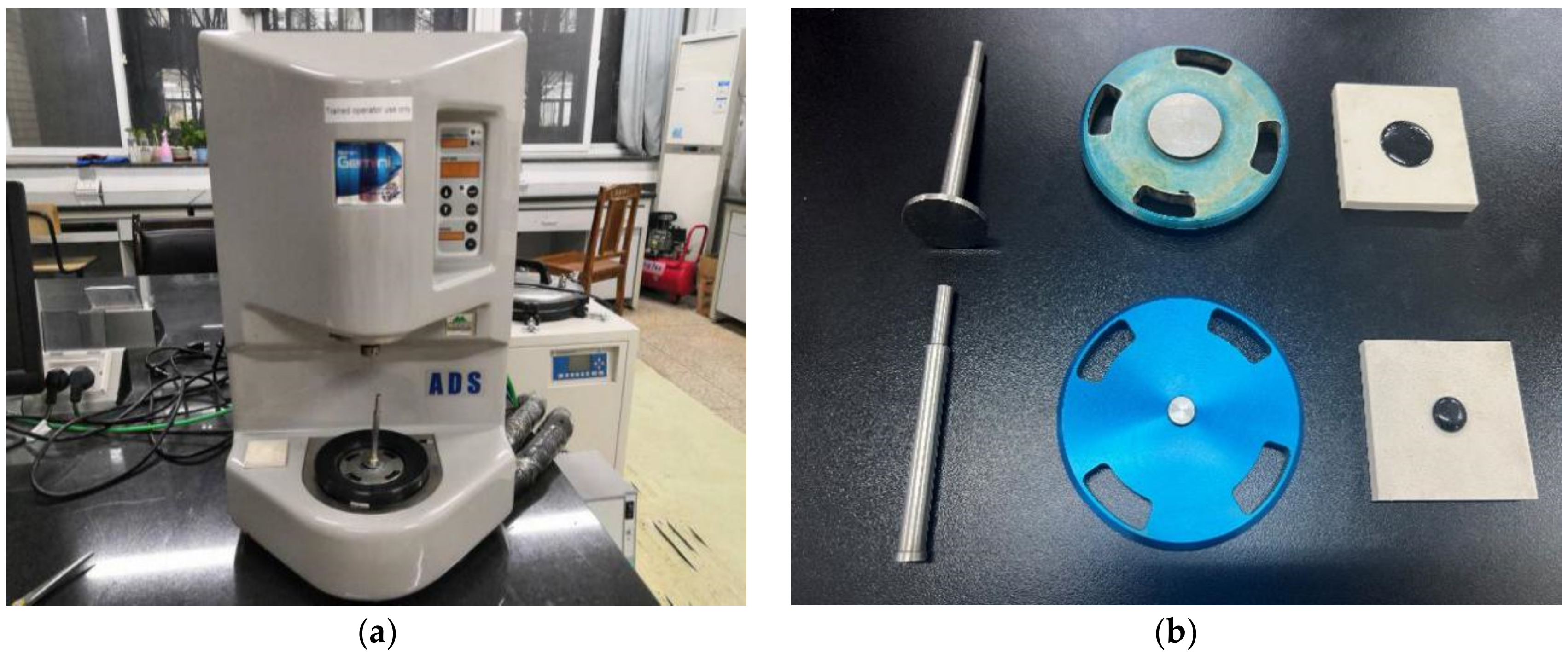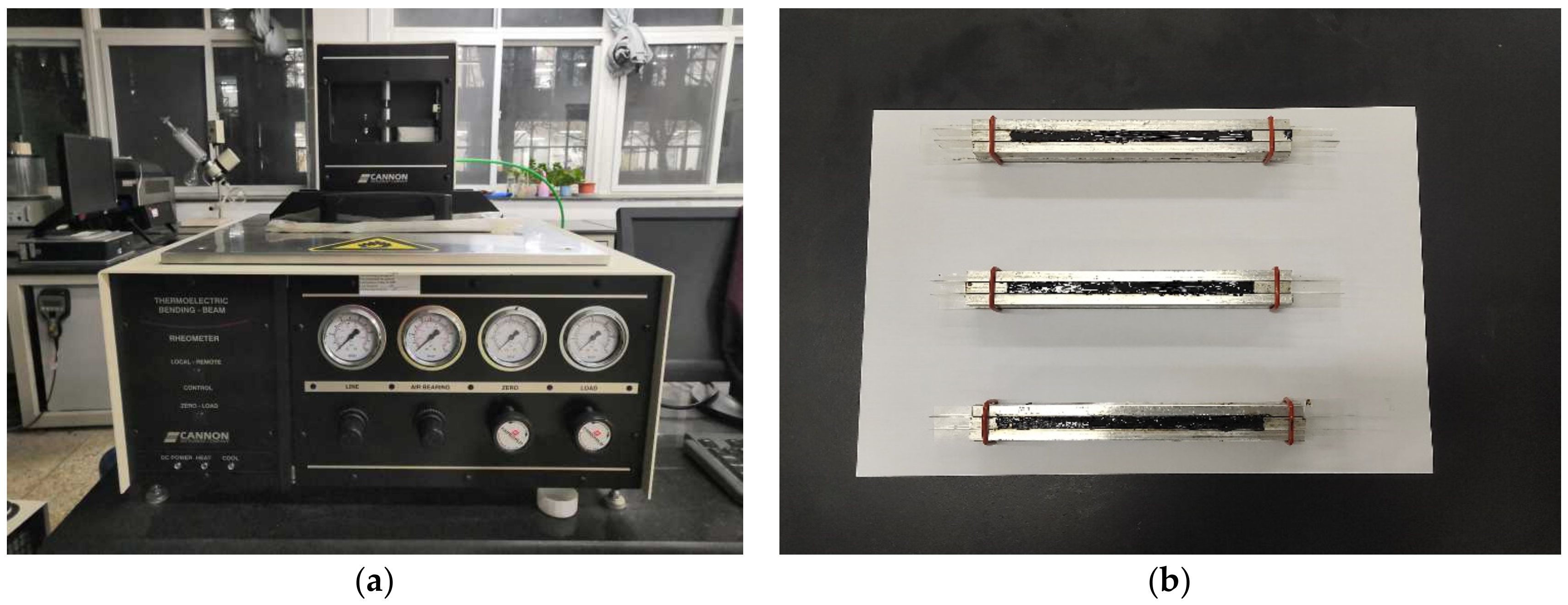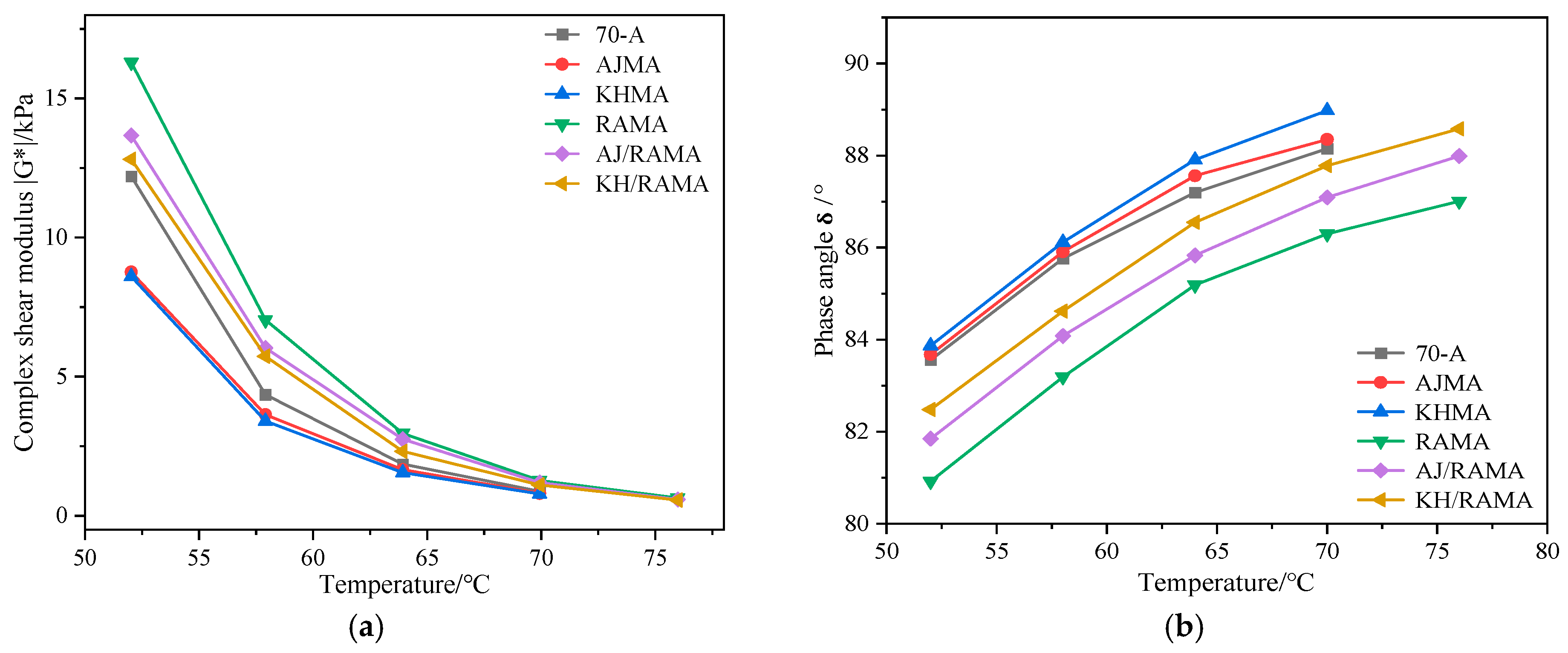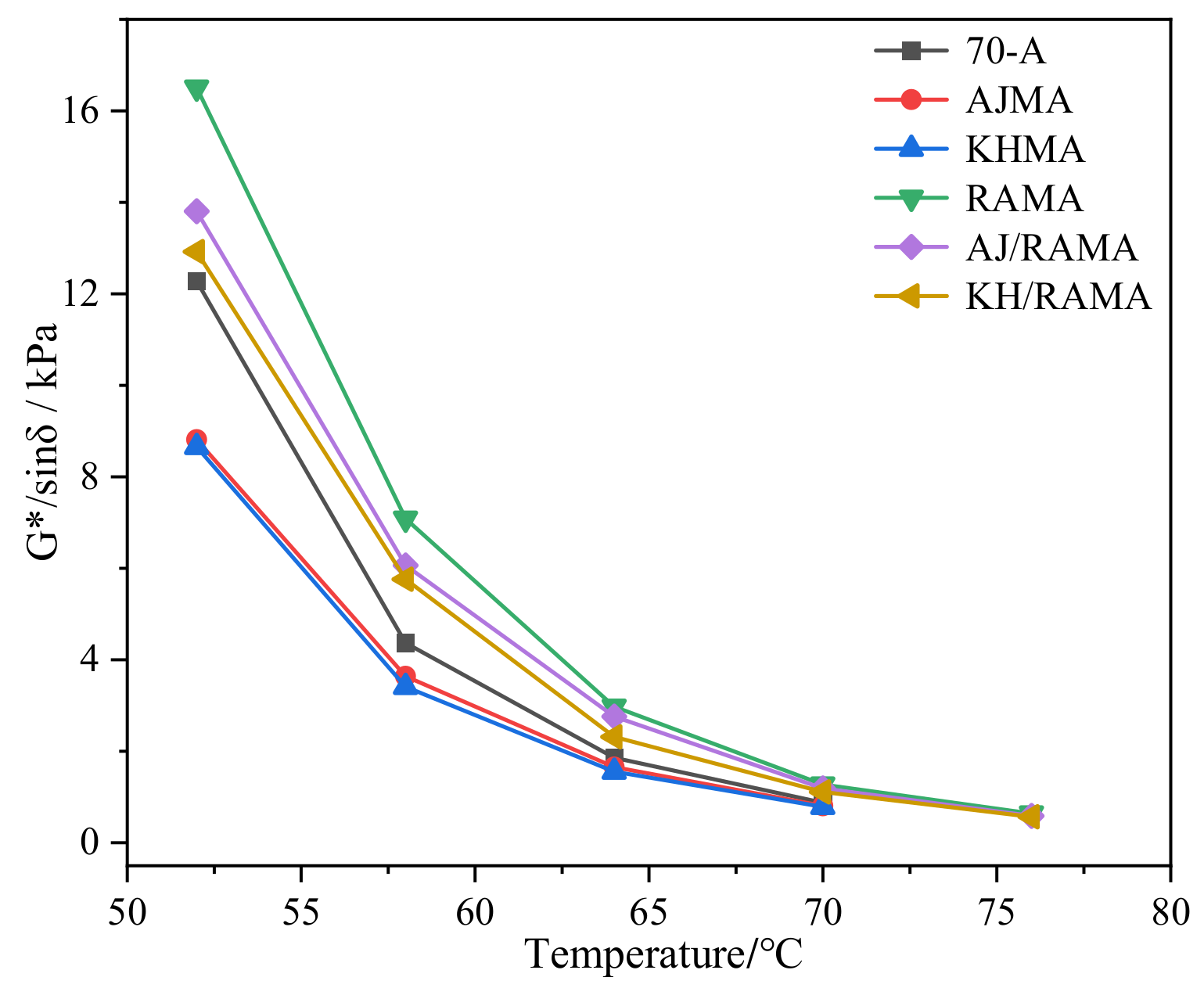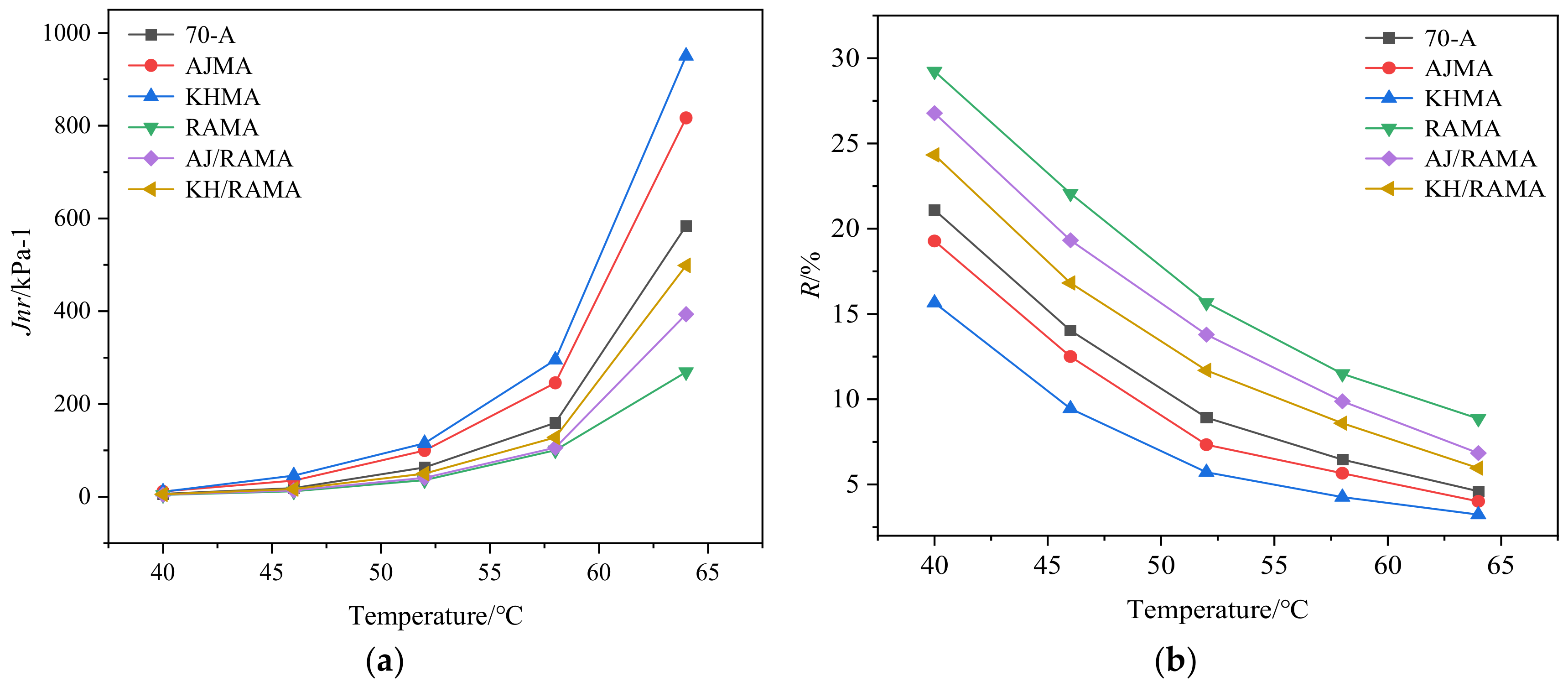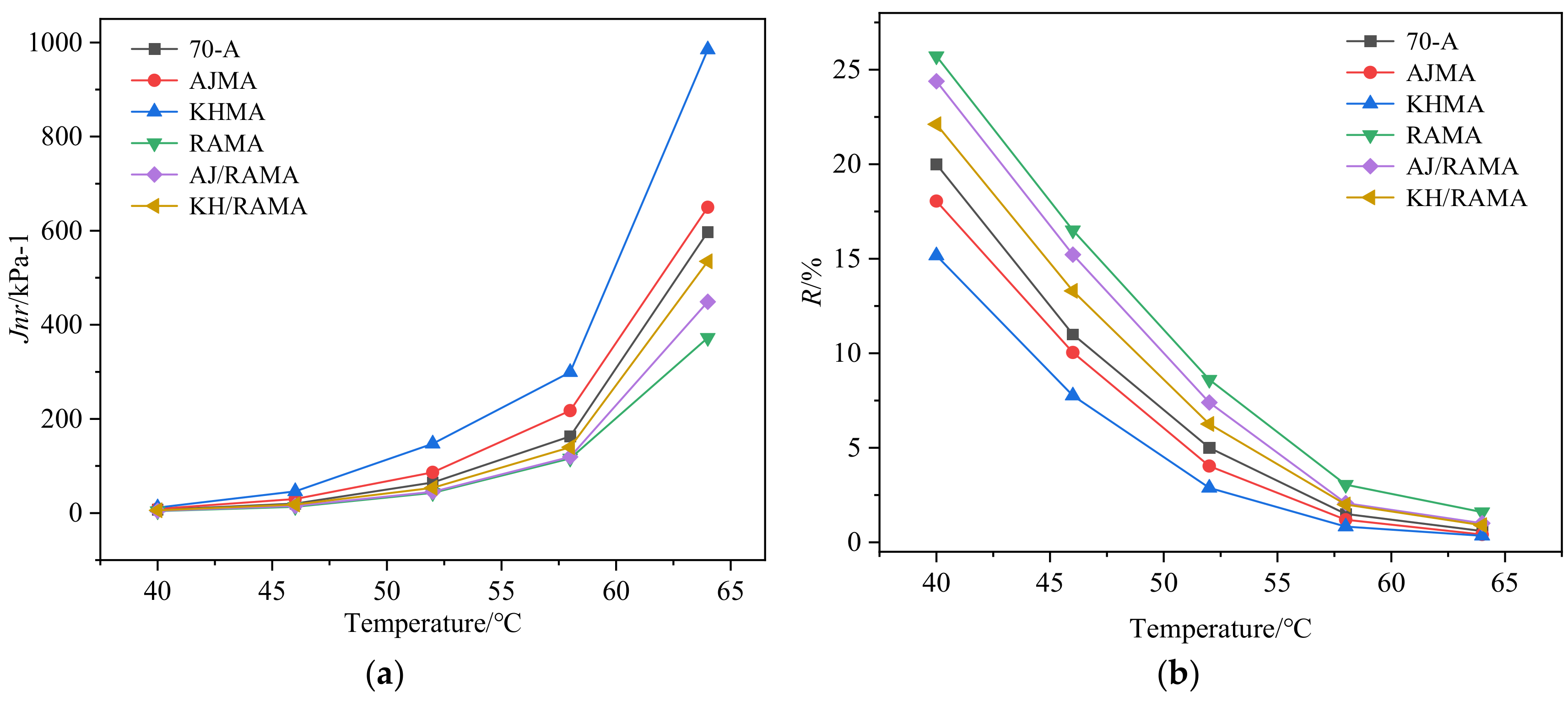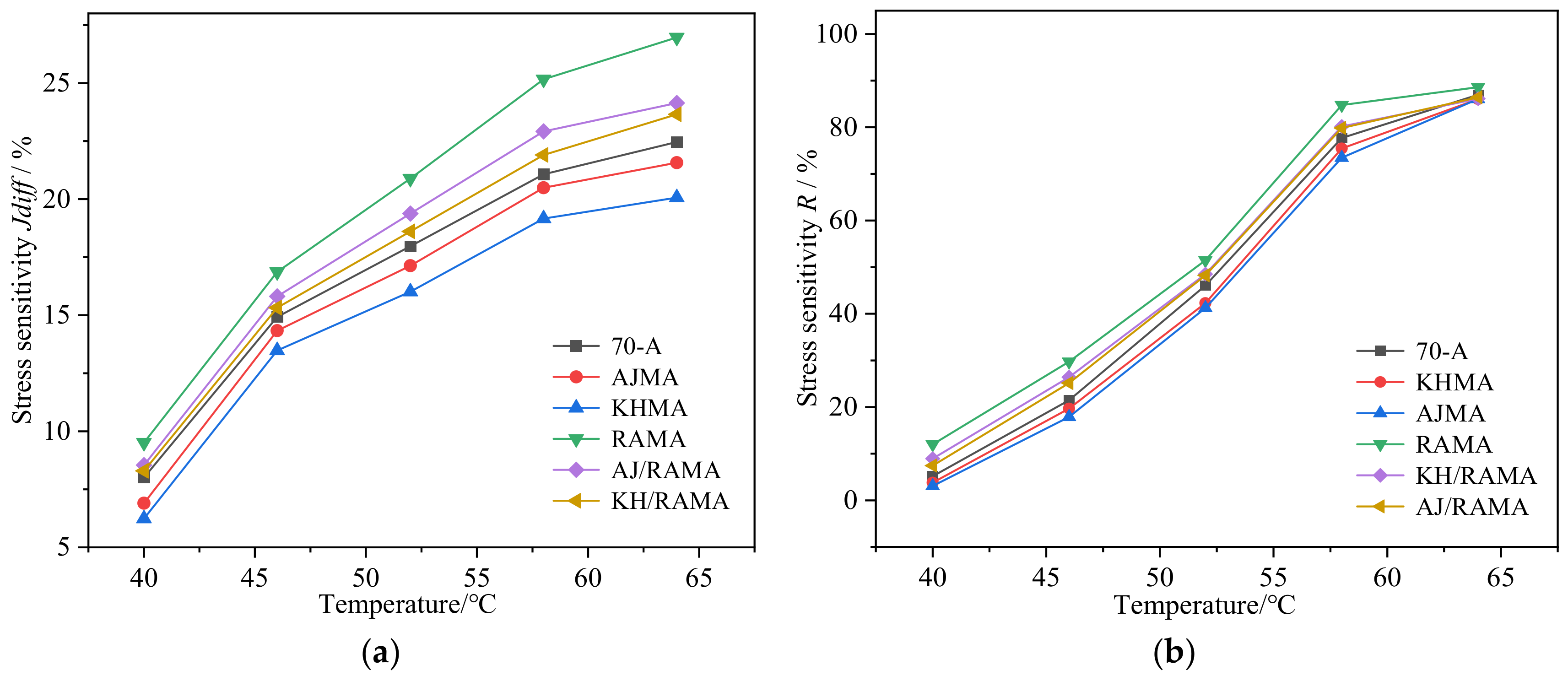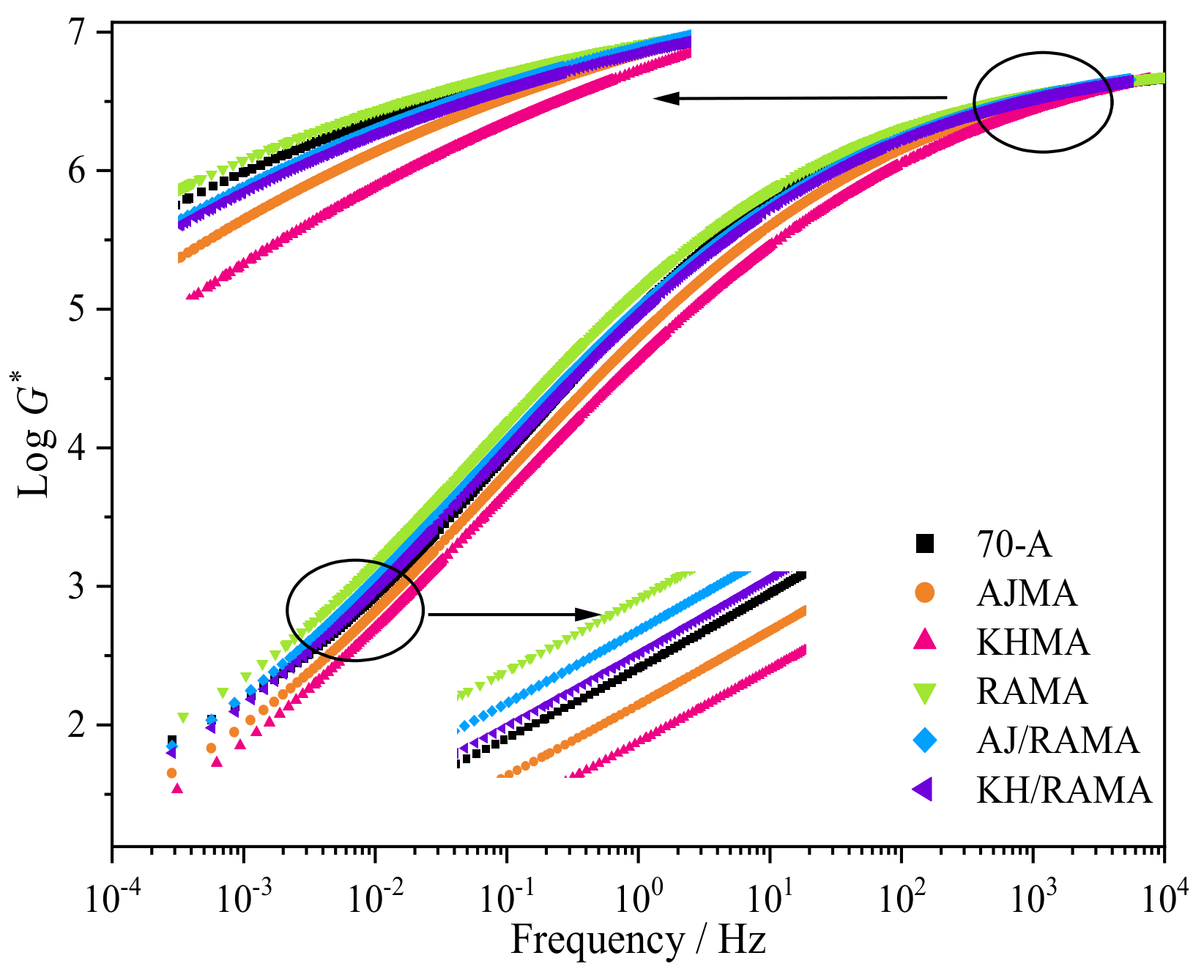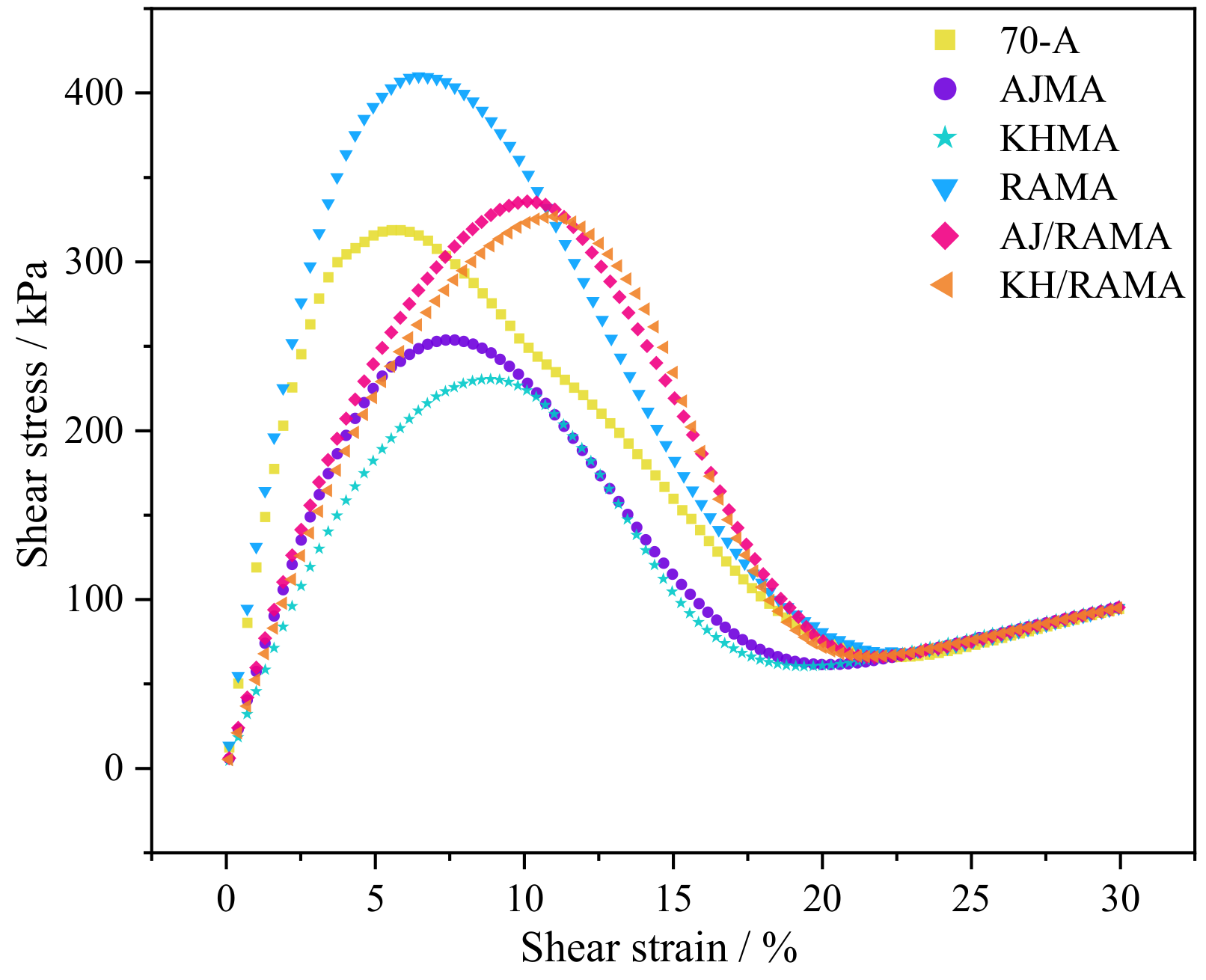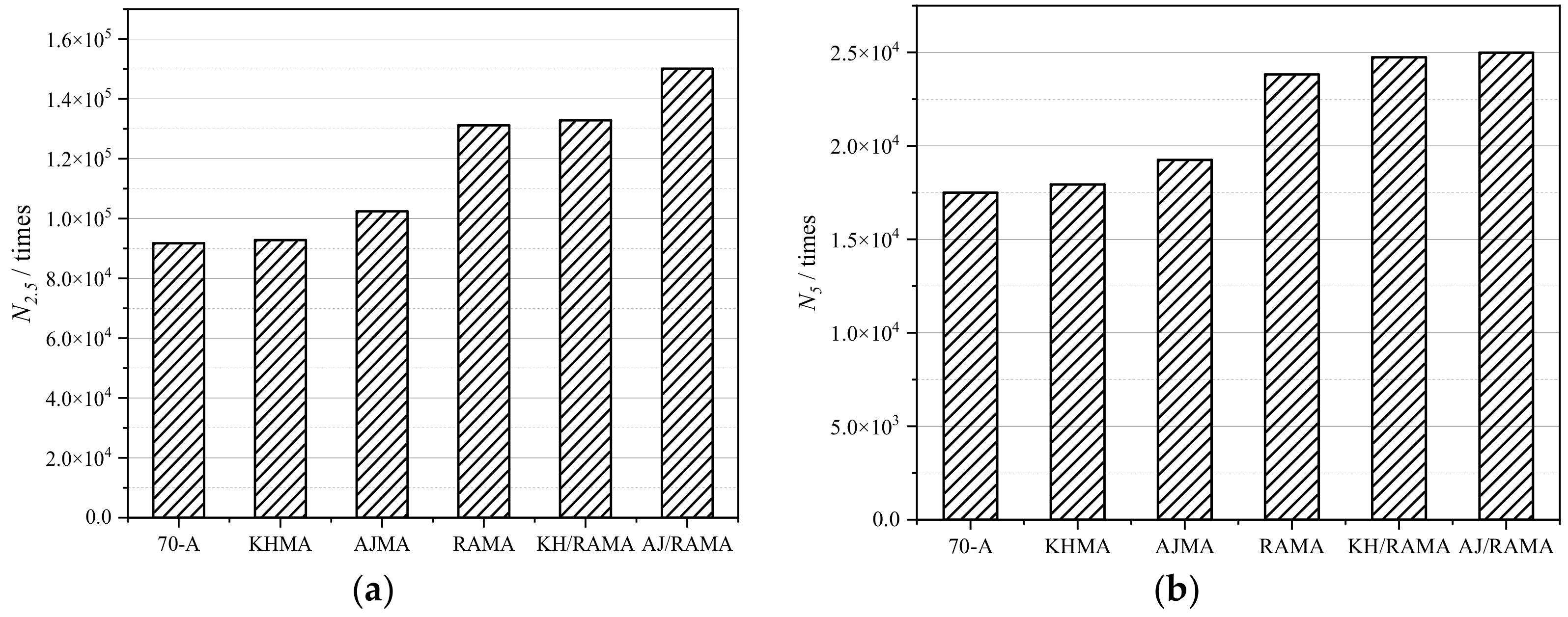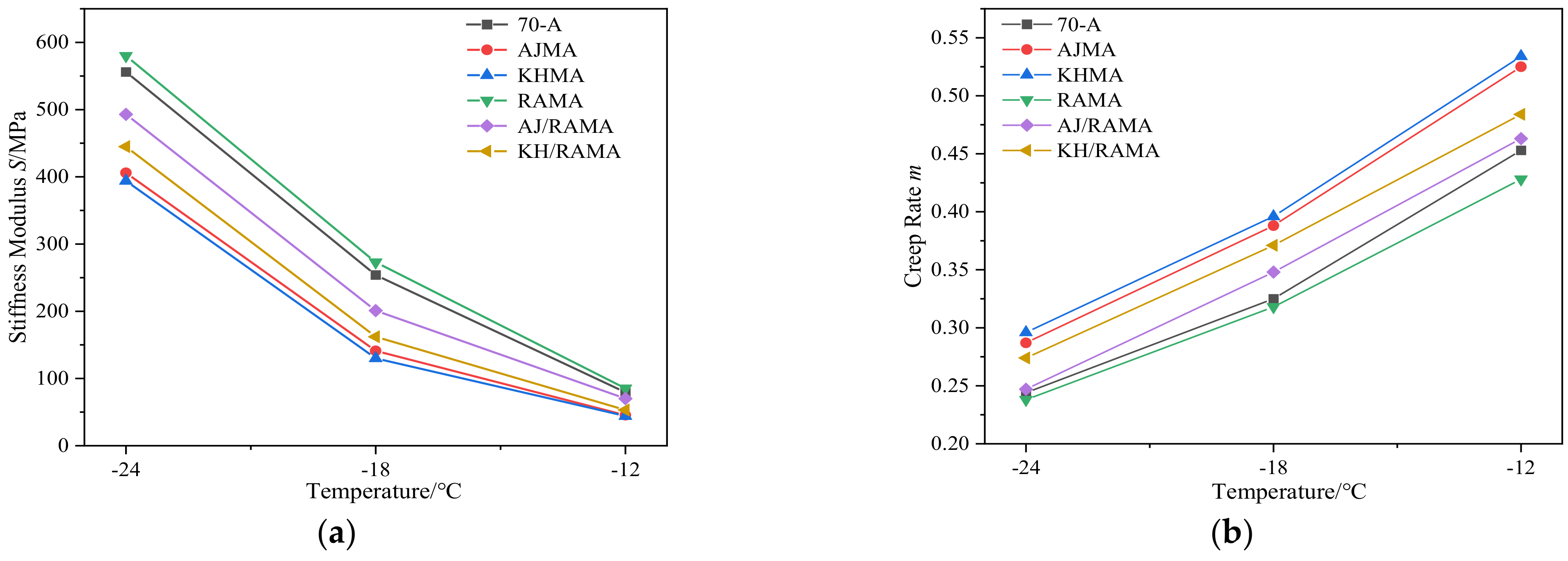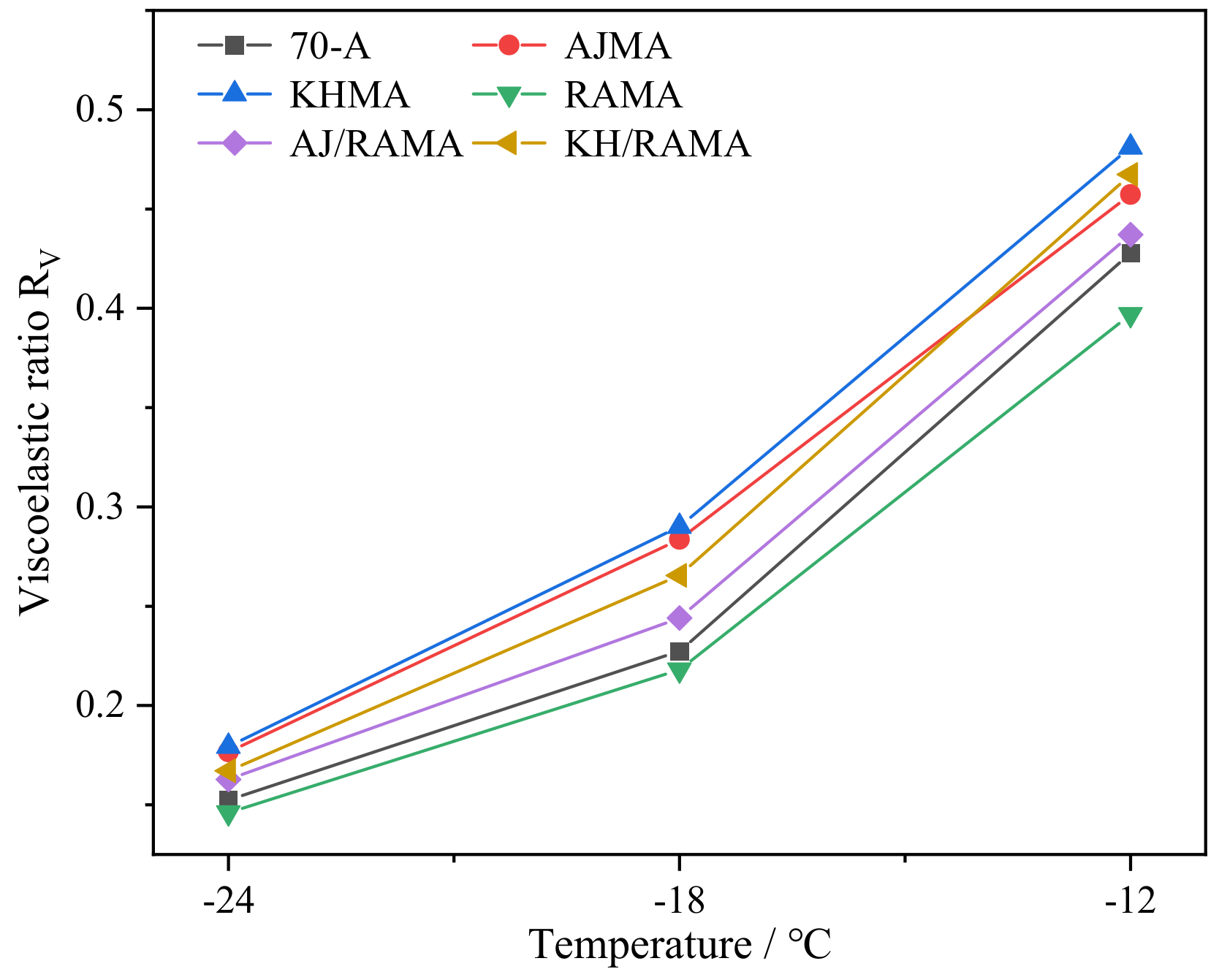1. Introduction
Water damage to asphalt pavement is one of the main forms of early road asphalt pavement disease, which seriously affects the service life and function of asphalt pavement [
1]. The causes of asphalt pavement early water damage are multifaceted, in addition to the large void ratio of the asphalt pavement site, but also related to the inherent factors such as hydrophilic and oil-repellent characteristics of the aggregate and the emulsification of the asphalt film itself. Due to the hydrophilic nature of the aggregate, the asphalt in the aggregate-asphalt interface is easily replaced by water molecules and is destroyed by adhesion to the aggregate surface under vehicle loading [
2,
3]. In addition, water molecules in the role of vehicle loading and negative pressure adsorption from the surface of the asphalt film diffuse into the asphalt film inside, resulting in the asphalt film “emulsification”, which reduces their cohesion strength and makes the asphalt susceptible to bond loss under strain [
4,
5,
6]. In view of the water damage to asphalt pavements, the addition of anti-stripping agents in asphalt mixtures is an effective measure [
7], so asphalt anti-stripping agents have been widely used in road engineering and construction.
Asphalt anti-stripping agent is a generic term for a class of asphalt modifiers whose main role is to produce physical adsorption or chemical reaction between asphalt and aggregate to form a solid asphalt-aggregate interaction interface, thereby improving the adhesion between asphalt and aggregate and enhancing the water damage resistance of asphalt pavements [
8,
9]. The development of asphalt anti-stripping agents has gone through four stages so far, the first being inorganic anti-stripping agents represented by lime and cement powders, which are low cost, easy to use, and have more stable performance. However, cement, lime, and other inorganic anti-stripping agents in the asphalt mixture are easy to agglomerate, difficult to mix uniformly, and to a certain extent, restrict the promotion and application of this type of anti-stripping agent. Secondly, the metal saponification anti-flaking agents are represented by soap and iron, with the advantages of low cost and ease of use, but due to the poor compatibility of metal saponification and asphalt, they easily produce segregation, so in practice the application of such anti-flaking agents is less common. Similarly, quaternary ammonium salts, representative of the surface-active substances, are not only expensive but also prone to decomposition failure under high temperature conditions, and so are currently used less. Finally, polymer-based anti-flaking agents not only are easy to use, but also have a good potential for improvement [
10].
At present, there are two main types of asphalt anti-stripping agents most widely used on roads, which are inorganic anti-stripping agents such as lime and cement and polymeric anti-stripping agents. Lime, cement, and other inorganic anti-stripping agents are the earliest anti-stripping agents, whose main role is to reduce the negative charge of the aggregate surface, thus activating the aggregate surface and improving the interfacial bond between the aggregate and asphalt [
11]. Wang studied the effect of slaked lime powder, cement, and liquid anti-stripping agent on the improvement of water stability of a granite-asphalt mixture using the Hamburg rutting test, and the results showed that the slaked-lime powder mixed with granite-asphalt mixture had the best water stability, followed by cement [
12]. Zaidi studied the effect of slaked lime on the water stability of asphalt mixes by surface energy tests and proposed the optimum lime dosing based on water stability [
13]. Hajj investigated the effect of the slaked-lime admixture method on the performance of asphalt mixes and found that treating acidic stones with lime water or directly replacing some of the mineral powder with slaked lime had almost no effect on the water stability of the mixes [
14]. Han analyzed the effect of slaked lime on the adhesion of matrix asphalt to acidic stones under dry and wet conditions based on surface energy theory. It was found that the total surface-energy parameter of asphalt decreased after slaked lime incorporation, while the polar component of surface energy increased and the resistance to water damage was enhanced [
15].
There are various types of polymer-based anti-flaking agents, which can be divided into amine anti-flaking agents and non-amine anti-flaking agents according to their chemical composition, with amines predominating. Amine anti-stripping agents are surface-active compounds, mainly based on aliphatic amines, phthalamido polyamines and imidazolines. Amine anti-stripping agents enter into the asphalt mixture, where their polar groups can chemically cross-link with aggregate surfaces and non-polar groups can act as part of the interaction with asphalt compounds to generate stable hydrocarbon chains, with hydrophilic aggregates and hydrophobic asphalt surfaces acting as hydrocarbon chains to connect. Thus, the amine anti-stripping agents can better enhance the adhesion of asphalt and aggregates [
16,
17]. Hesami investigated the effect of two liquid amine-based anti-stripping agents on the performance of HMA by means of tensile strength ratio and semicircular bending tests. The results of the study showed that the resistance to water damage was significantly reduced after hot mixing and hot paving [
18]. Lucas Junior investigated the effect of amine-based anti-stripping agents on the fatigue life of asphalt mixes and found that the incorporation of anti-stripping agents improved the fatigue performance of asphalt mixes [
19]. Park evaluated the water stability of asphalt mixture using the tensile strength ratio and image analysis method and proposed that this type of anti-peeling agent can improve the peeling and rutting resistance of asphalt mixture [
20]. Zhu developed a non-amine asphalt anti-stripping agent containing a phosphorus hydroxyl group as the main active component; the anti-stripping agent’s decomposition temperature was up to 200 °C or higher [
21]. Iskender investigated the effect of SBS polymers and aliphatic amine anti-stripping agents on the properties of asphalt mixtures and showed that the mixture of amine anti-stripping agents and SBS modifications resulted in asphalt mixtures with higher resilient modulus [
22]. With the intensive research on asphalt anti-stripping agents, researchers developed several new anti-stripping agents based on four anti-stripping agents. Ye et al. compared the effectiveness of various anti-stripping agents to improve the road performance of granite asphalt mixtures and suggested that the composite modification of Qingchuan rock asphalt and SBS improves the water stability of granite-asphalt mixtures optimally [
23]. Mansourkhaki modified rubber asphalt using the liquid nano-anti-peel agent Zycotherm, suggesting that Zycotherm has great potential for maintaining the rutting performance of rubber asphalt mixes [
24]. Behbahani found that nanotechnology-synthesized fermented oil can also be effective in improving the mechanical properties and water stability of asphalt mixtures [
25].
The addition of anti-stripping agents to asphalt can effectively improve the road properties and water stability of the mixture. However, at present, the research on anti-stripping agents mainly focuses on the macro road performance of mixtures, while the research on anti-stripping agents improving asphalt rheological performance is less frequent. The main purpose of this paper is to deeply analyze and understand the influence of different anti-stripping agents on the performance of matrix asphalt and provide a theoretical basis for future engineering practice. Considering the low-temperature performance of Qingchuan rock asphalt, this paper also uses two kinds of amine anti-stripping agents combined with Qingchuan rock asphalt to form a composite anti-stripping agent. Through asphalt rheological property tests, the improving effect of amine anti-stripping agents on the low-temperature performance of Qingchuan rock asphalt was studied. Therefore, three anti-stripping agents—Qingchuanyan asphalt, the aliphatic amine anti-stripping agent AJ-1, and the acylamine anti-stripping agent KH5—were selected to modify asphalt in this paper, and the rheological properties of asphalt were studied by means of a dynamic shear rheometer and a bending beam rheometer. Sigmoidal, Burgers, and VECD mathematical models (The full name of the model is shown in
Appendix A) were used to evaluate the effect of different anti-stripping agents on the rheological properties of asphalt. The intrinsic mechanism of anti-stripping agents to improve the bond between asphalt and aggregate and improve the performance of asphalt mixes was revealed, which provides a theoretical basis for the application of different anti-stripping agents in asphalt mixes.
3. Results and Discussion
3.1. Rheological Properties of Asphalt at High Temperature
The dynamic shear rheology test results mainly include the complex shear modulus
G* and the phase angle
δ. The complex shear modulus
G* represents the ratio of stress to strain in asphalt under alternating cycles of sinusoidal loading. The larger the value, the more resistant the asphalt is to deformation. The phase angle
δ indicates the hysteresis between the peak stress and peak strain of the asphalt specimen under alternating cycles of sinusoidal loading, and the difference between the two is the phase angle. The phase angle can characterize the ratio of elastic modulus to viscous modulus and the ratio of storage modulus to loss modulus; the larger the phase angle, the more obvious the viscous characteristics. The test results of the complex shear modulus
G* and phase angle
δ are shown in
Figure 3.
It can be seen from
Figure 3a that the complex shear modulus of the six groups of asphalt gradually decreases with the increase in temperature, indicating that the deformation resistance of asphalt gradually decreases with the increase in temperature. The comparison shows that the composite shear modulus of RAMA is larger than that of 70-A matrix asphalt, while the composite shear modulus of KHMA and AJMA is smaller than that of 70-A matrix. It can be inferred that rock asphalt can significantly improve the resistance of the asphalt to deformation at high temperatures, while KH5 and AJ-1 can reduce the resistance of the asphalt to deformation at high temperatures and are more likely to cause flow deformation of asphalt at the same temperature. The complex shear modulus of composite-modified asphalt is between matrix bitumen and RAMA, and it can be seen that the composite modifier can improve the high-temperature deformation resistance of asphalt, but the effect is less than that of rock asphalt. Meanwhile, the complex shear modulus of KHMA is slightly smaller than AJMA, indicating that the same dose of KH5 and AJ-1 can reduce the high-temperature deformation resistance of matrix asphalt and RAMA, and the effect of KH5 is slightly stronger than that of AJ-1.
From
Figure 3b, it can be seen that the phase angle of the six groups of asphalt gradually increases with the increase in temperature, which indicates that the proportion of viscous components increases with the increase in temperature, while the proportion of elastic components decreases and the mechanical properties of asphalt tend to be viscous liquid. The phase angles of the six asphalt groups are in the following order: KHMA > AJMA > 70-A > KH/RAMA > AJ/RAMA > RAMA. It can be seen that rock asphalt and the two groups of composite modifiers can increase the proportion of elastic components in the matrix asphalt, KH5 and AJ-1 can increase the proportion of viscous components in the matrix asphalt, and the phase angle of AJMA is smaller than that of KHMA, which means that KH5 has more viscous components than AJ-1.
As shown above, the complex modulus describes the asphalt’s capacity to resist deformation, while the phase angle shows the amount and impact of the viscoelastic characteristics or modulus. The asphalt with the lower phase angle is more elastic and recovers more readily after unloading if there are two asphalts with identical complex shear modulus but different phase angles. This indicates that the single use of complex modulus to evaluate the high-temperature stability of asphalt is not sufficient, and the magnitude of the phase angle must also be considered. Therefore, to accurately evaluate the high-temperature performance of asphalt, the American SHRP plan proposed the rutting factor
G*/sin
δ as an indicator to measure the high-temperature performance of asphalt. According to the definition, the rutting factor represents the reciprocal of the asphalt loss shear flexibility J’. In terms of creep flexibility, J’ is the energy dissipation component of the asphalt creep process, and the larger the rut factor, the less energy consumption the asphalt produces at high temperatures, and the smaller the flow deformation generated. In this section, the high-temperature performance of six groups of asphalt was analyzed according to the rutting coefficient, and the test results are shown in
Figure 4.
The rutting factor can be used to visually compare the magnitude of the high-temperature performance of modified asphalt, but the effect of anti-stripping agents on the high-temperature performance of asphalt cannot be quantitatively evaluated. To address this problem, some researchers propose to use Equation (11) to exponentially fit the rutting factor at different temperatures to obtain the relationship curve between the rutting factor and the test temperature, according to the PG grading standard (original asphalt
G*/sin
δ ≥ 1.0 kPa) to find the temperature
THS when the asphalt rutting factor reaches the critical value. The critical temperature is used to quantitatively evaluate the deformation resistance of asphalt at high temperature, and the higher the critical temperature, the better the deformation resistance of asphalt at high temperature. The relationship curve and critical temperature
THS are shown in
Table 4.
where
A and
B denote regression coefficients, dimensionless, and
T donates test temperature, °C.
3.2. Results of Multiple Stress Creep Recovery Test
According to the test findings, the relationship curve between the asphalt’s creep recovery properties and temperature exhibits the same change law at all stress levels. As the temperature rises, the unrecoverable compliance Jnr of the six groups of asphalt gradually rises and the creep recovery rate R gradually falls. The viscoelastic characteristics of asphalt are nonlinear, and these changes are accompanied by a steady increase in the unrecoverable compliance Jnr. This shows that with the increase in temperature, the proportion of plastic deformation of asphalt under external force increases gradually, and viscous flow is more likely to occur. At the same time, the proportion of elastic recovery deformation of asphalt decreases gradually, and the deformation resistance decreases.
The irrecoverable creep and creep recovery rate test results are shown in
Figure 5 and
Figure 6. Whether under high stress level or low stress level, with the increase in temperature, the order of magnitude of creep recovery rate R of the six groups of asphalt is RAMA > KH/RAMA > AJ/RAMA > 70-A > KHMA > AJMA, while the irreversible creep compliance Jnr is in the opposite order. According to the test results, it can be seen that rock asphalt and two groups of composite modifiers can improve the creep recovery rate of the matrix asphalt while reducing the amount of non-recoverable creep flexibility of asphalt; that is, to improve the elastic recovery capacity of asphalt, reduce the proportion of plastic deformation of asphalt, and increase deformation resistance of asphalt at high temperature. It can be seen from
Figure 7 that the stress sensitivity of asphalt gradually increases when the temperature rises. Moreover, rock pitch and two sets of composite modifiers can reduce stress sensitivity, and KH5 and AJ-1 can increase the stress sensitivity of matrix bitumen.
3.3. Complex Shear Modulus Master Curve
In this paper, the test data were processed based on the time-temperature equivalence principle and Sigmoidal model, and the shift factors and test parameters of the six asphalt groups are shown in
Table 5. According to the shift factor lgαT in
Table 5 and the test parameters C
1 and C
2, the time-temperature equivalent transformation of the complex shear modulus is carried out for each group of asphalt to obtain the change of the composite shear modulus of the asphalt in the broadband domain, respectively. The experimental results of the master curve of asphalt modulus are shown in
Figure 8.
From
Figure 8, it can be seen that the composite modulus of asphalt gradually increases as the load frequency increases and the load action time decreases. In the low-frequency region, the order of complex modulus magnitude is RAMA > AJ/RAMA > KH/RAMA > 70-A > AJMA > KHMA, which is consistent with the above analysis of asphalt high temperature performance. However, in the high-frequency region, the order of complex modulus magnitude changed: RAMA > 70-A > AJ/RAMA > KH/RAMA > AJMA > KHMA. Moreover, the logarithmic values of the complex modulus of the six groups of asphalt converged. As can be seen, the relative importance of KHMA, AJMA, and RAMA does not change across the board as the frequency changes, but in the high-frequency region, according to the time–temperature equivalence principle, it is equivalent to the influence of low-temperature action, and the asphalt’s elastic properties take up a disproportionate amount of space. Regardless of whether the loading frequency is in the high- or low-frequency region, the complex modulus of RAMA is always greater than that of matrix bitumen, the complex modulus of KHMA and AJMA is always smaller than that of matrix bitumen, and the complex modulus of KHMA is always smaller than that of AJMA. The findings demonstrate that the addition of matrix asphalt to Qingchuan rock bitumen increases its deformation resistance at any loading frequency and that KH5 and AJ-1 may enhance the flow-deformation capability of matrix asphalt at any loading frequency. This is mainly because rock asphalt contains a large amount of asphaltene, whose chemical structure is similar to the matrix asphalt and has good compatibility, so when rock asphalt is added to the matrix asphalt, the polymerization generates a macromolecular mesh structure, which makes RAMA’s resistance to deformation in a wide frequency domain increase significantly. The KH5 and AJ-1 amine anti-peeling agents themselves contain more light components such as oil, which increases the proportion of viscous components of asphalt, reduces the elastic recovery ability, reduces the deformation resistance of asphalt, and is more likely to produce flow deformation in a wide frequency domain.
3.4. Rheological Properties of Asphalt at High Temperature
From
Figure 9, it can be seen that in the LAS test (The full name of the model is shown in
Appendix A), the stress-strain curves of the six groups of asphalt specimens show the same trend. As shear strain increases, the shear stress for the asphalt specimens likewise steadily rises until it reaches its maximum value before falling quickly and convergently. According to the AASHTO TP 101-14 specification, the peak stress in the linear amplitude scan test is defined as the fatigue failure point of the asphalt specimen, i.e., the yield stress, while the strain corresponding to the peak stress is called the yield strain. From
Figure 9, it can be seen that the yield stress magnitudes of its six asphalt specimens are ranked as follows: RAMA > AJ/RAMA > 70-A > KH/RAMA > AJMA > KHMA, while the yield strain magnitudes are ranked as follows: KH/RAMA > AJ/RAMA > KHMA > AJMA > RAMA > 70-A. It can be seen that different anti-stripping agents have different effects on the fatigue performance of asphalt. Rock asphalt can greatly increase the yield stress of matrix bitumen but can only slightly increase the yield strain of matrix asphalt. The effect of KH5 and AJ-1 on the fatigue performance of matrix asphalt is similar, which can effectively improve the yield strain of matrix asphalt, but will significantly reduce the yield stress of matrix asphalt. The yield stress of the two groups of composite-modified bitumen is very close to that of the matrix bitumen, but the yield strain is greatly improved.
The linear amplitude scanning test results were processed to create asphalt damage characteristic curves based on the viscoelastic continuum damage model (VECD) theory, as illustrated in
Figure 10. The ordinate in the figure is the asphalt specimen integrity coefficient (C), and the abscissa is the asphalt specimen cumulative loss parameter (D). According to the definition, when C = 0, the asphalt specimen is undamaged, and the asphalt specimen is in a completely damaged state when C = 1. When the cumulative damage parameters are constant, the greater the material integrity coefficient C, the stronger the resistance of the asphalt specimen to damage. The slope of the damage curve at this point, when a cumulative damage parameter
D is applied, is also referred to as the damage rate of the asphalt material. The larger the absolute value of the slope, the faster the virtual modulus of the asphalt decreases, and the more likely the asphalt material is to produce fatigue damage. As can be seen from the figure, the damage rates of the six groups of asphalt specimens are very close to each other, and when a cumulative damage parameter D is determined, the 70-A matrix asphalt integrity factor is smaller than that of the other five groups of modified asphalts, indicating that all five groups of anti-stripping agents can improve the fatigue performance of the matrix asphalt. The integrity coefficients C of KHMA and AJMA are slightly higher than that of matrix asphalt. It can be seen that KH5 and AJ-1 can improve the fatigue performance of matrix asphalt to a small extent, while RAMA has a significant increase in integrity coefficient compared with asphalt, and it can be seen that rock asphalt can effectively improve the fatigue performance of asphalt. At the same time, the integrity coefficient C of the two groups of composite-modified asphalt is greater than the other four groups of asphalt, which shows that the fatigue performance of the composite modification is higher than that of the single anti-stripping-agent-modified asphalt.
The fatigue performance of asphalt has been preliminarily judged according to the asphalt damage characteristic curve, but the damage characteristic curve can only represent the process of damage evolution of the material during loading, and cannot be used alone as a basis for accurately predicting the fatigue life of the asphalt. Therefore, to accurately predict the fatigue life of asphalt materials and to quantitatively analyze the effect of different anti-stripping agents on the fatigue life of asphalt, a strain level of 5% for low-stiffness asphalt concrete pavement and 2.5% for high-stiffness asphalt concrete pavement, respectively, was used in this paper to estimate the life of asphalt materials according to Ashish et al. [
34] The experimental data are processed according to the VECD model, the model parameters are shown in
Table 6, and their experimental results are shown in
Figure 11.
As can be seen from
Figure 11, the fatigue-life levels of the six groups of asphalt are ranked as follows: KH/RAMA > AJ/RAMA > RAMA > KHMA > AJMA > 70-A. At the 2.5% strain level, the fatigue life of all five groups of modified asphalt is improved compared with the base asphalt, and the fatigue life improvements in large-stiffness pavements are AJMA (5.21%), KHMA (16.08%), RAMA (46.14%), AJ/RAMA (48.72%), and KH/RAMA (50.63%). When the strain level reaches 5%, the fatigue life of asphalt materials has decreased significantly, but the fatigue life of five groups of modified asphalt is still improved compared with matrix asphalt, and the improvements of fatigue life of modified asphalt are AJMA (1.49%), KHMA (11.6%), RAMA (15.74%), AJ/RAMA (38.12%), and KH/RAMA (43.47%). According to the data analysis, the five groups of anti-stripping agents improved the fatigue life of asphalt materials. Rock asphalt can significantly improve the fatigue life of asphalt materials, and rock asphalt and KH5 composite modifier have the greatest improvement in the fatigue life of the asphalt.
3.5. Rheological Properties of Modified Asphalt at Low Temperature
From
Figure 12, it can be seen that as the temperature decreases, the stiffness modulus of asphalt gradually increases and the creep rate decreases. It can be seen that as the temperature decreases, the stiffness of asphalt increases, the deformation capacity becomes worse, and the elastic properties of asphalt material gradually dominate, making the asphalt closer to a Hooke elastomer. By comparison, it can be found that the order of stiffness modulus of the six groups of asphalt at different temperatures is consistently RAMA > 70-A > KH/RAMA > AJ/RAMA > KHMA > AJMA, while the creep rate is the opposite. It can be seen that rock asphalt can increase the stiffness of the asphalt material, making the low-temperature crack resistance and stress-relaxation capacity of asphalt significantly reduced, mainly because the ash and asphaltene contained in rock asphalt increase the brittleness of asphalt and weaken the low-temperature crack resistance [
34]. KH5 and AJ-1 can improve the low-temperature deformation ability and stress-relaxation ability of asphalt, mainly because KH5 and AJ-1 contain more light components such as oil, which increases the viscous components in the matrix asphalt and increases the flexible deformation ability of asphalt at low temperature. Compared with RAMA, the low-temperature deformation ability and stress-relaxation ability of composite-modified asphalt have been significantly improved, indicating that KH5 and AJ-1 make up for the shortcomings of RAMA’s low-temperature performance.
To study the low-temperature performance of asphalt more accurately, this section fits the stiffness modulus S value and creep rate m value of six groups of asphalt according to Equations (12) and (13). The TS and Tm in the formula represent the temperatures. The temperature gradient of low-temperature PG grading of conventional asphalt is 6 °C. In order to more accurately describe the effect of anti-stripping agents on the low-temperature rheological properties of asphalt, the stiffness modulus S ≤ 300 MPa and creep rate m ≥ 0.3 were used as the limits. According to the fitting curve, the critical temperature of asphalt at low temperature is obtained. Therefore, it can quantitatively express the influence of different anti-stripping agents on the low-temperature rheological properties of asphalt.
Equations (12) and (13) obtain the relationship curves between the low-temperature rheological parameters of asphalt and temperature, solve the low-temperature critical temperature
TLC of asphalt according to the asphalt low-temperature PG classification standard, and quantitatively analyze the influence of different anti-stripping agents on the low-temperature performance of asphalt by using the low-temperature critical temperature of asphalt. The test results are shown in
Table 7. According to
Table 7, compared with 70-A matrix asphalt, the low-temperature critical temperature of AJMA and KHMA were increased by 12.45% and 13.75%, respectively, which shows that the same dose of KH5 and AJ-1 have similar effects on improving the low-temperature rheological properties of the matrix asphalt. It can be demonstrated that KH5 and AJ-1 can enhance the low-temperature rheological performance of RAMA, although KH5’s impact is much bigger than AJ-1’s. In comparison to RAMA, the low-temperature critical temperature of AJ/RAMA and KH/RAMA rose by 6.39% and 12.66%, respectively.
The viscoelastic ratio
RV of asphalt at low temperature is generally regarded as the ratio of viscous flow flexibility to elastic flexibility, as shown in
Figure 13. In this paper, the test temperatures were −12, −18, and −24 °C, and the time t = 60 s. The calculated results of the low temperature and elasticity ratio of asphalt are shown in
Figure 13.
From the figure, as the temperature decreases, the viscoelastic ratio of the six groups of asphalt gradually decreases, indicating that the viscous modulus of asphalt gradually decreases, the elastic modulus gradually increases, the asphalt tends to be an elastic solid, and the crack resistance of low temperature is weakened. The comparison shows that the viscoelastic ratio of RAMA is smaller than that of matrix asphalt, indicating that rock asphalt increases the elastic deformation ratio of matrix asphalt at low temperature, decreases the low-temperature deformation capacity of asphalt, and increases the risk of low-temperature cracking. Moreover, KHMA, AJMA, KH/RAMA, and AJ/RAMA viscoelastic ratios are larger than that of matrix asphalt, indicating that KH5 and AJ-1 can effectively increase the percentage of viscous deformation of matrix asphalt and RAMA at low temperature, which increases the low-temperature crack resistance of asphalt.
4. Conclusions
The effects of different anti-stripping agents on the high-temperature deformation resistance, low-temperature cracking resistance, and fatigue performance of asphalt were analyzed by studying the rheological properties of asphalt with different anti-stripping agents. At the same time, the viscoplastic changes of asphalt materials at different temperatures and loading frequencies were analyzed by combining mathematical models, and the main conclusions are as follows:
Rock asphalt can significantly improve the high-temperature deformation resistance of asphalt. The addition of KH5 and AJ-1 alone reduced the high-temperature performance of asphalt, and the high-temperature deformation resistance of asphalt was RAMA > AJ/RAMA > KH/RAMA > 70-A > AJMA > KHMA in order;
Based on the VECD model to analyze the fatigue life of asphalt, rock asphalt, KH5, AJ-1 and KH/RA, and AJ/RA all improved the fatigue performance of asphalt. The fatigue performance of KH/RA and AJ/RA composite-modified asphalt was higher than that of single anti-stripping-agent-modified asphalt, and the KH/RAMA composite modification improved the fatigue life of asphalt the most;
Rock asphalt significantly increased the yield stress of asphalt, but the yield strain enhancement was small. KH5 and AJ-1 effectively enhanced the yield strain and reduced the yield stress of asphalt. The yield stresses of KH/RAMA and AJ/RAMA composite-modified bitumen were close to that of matrix bitumen, but their yield strains was greatly improved;
In a low-temperature environment, the size of the asphalt creep rate of the different anti-stripping agents ranked as AJMA > KHMA > AJ/RAMA > KH/RAMA > 70-A > RAMA, and AJ/RAMA and KH/RAMA composite-modified asphalt had significantly higher low-temperature softening ability and stress-relaxation ability, indicating that KH5 and AJ-1 make up for the lack of RAMA low-temperature performance to a great extent;
As the temperature decreased, the viscoelastic ratio of matrix bitumen and modified asphalt gradually decreased with the addition of anti-stripping agents, and the asphalt tended to be an elastic solid with weaker low-temperature crack resistance. RAMA further increased the elastic deformation ratio of asphalt at low temperatures and increased the risk of cracking at low temperatures. The viscoelastic ratios of KHMA, AJMA, KH/RAMA, and AJ/RAMA were larger than that of matrix bitumen, and the low temperature performance was better.
This paper comprehensively evaluated the effect of Qingchuan rock asphalt and amine anti-stripping agent on the rheological properties of asphalt. At the same time, two groups of composite anti-stripping agents, Qingchuan rock asphalt/silane coupling agent and Qingchuan rock asphalt/amine anti-stripping agent, are proposed. The two groups of anti-stripping agents not only make up for the low-temperature performance of Qingchuan rock asphalt, but also can effectively improve the high-temperature performance and fatigue performance of asphalt, making asphalt more suitable for high temperatures and rainy high-grade pavement. This paper provides theoretical support for the application of Qingchuan rock asphalt and amine anti-stripping agent in road engineering. The research results meet the requirements of sustainable development, and have a very broad application prospect and good social, economic, and ecological benefits.
